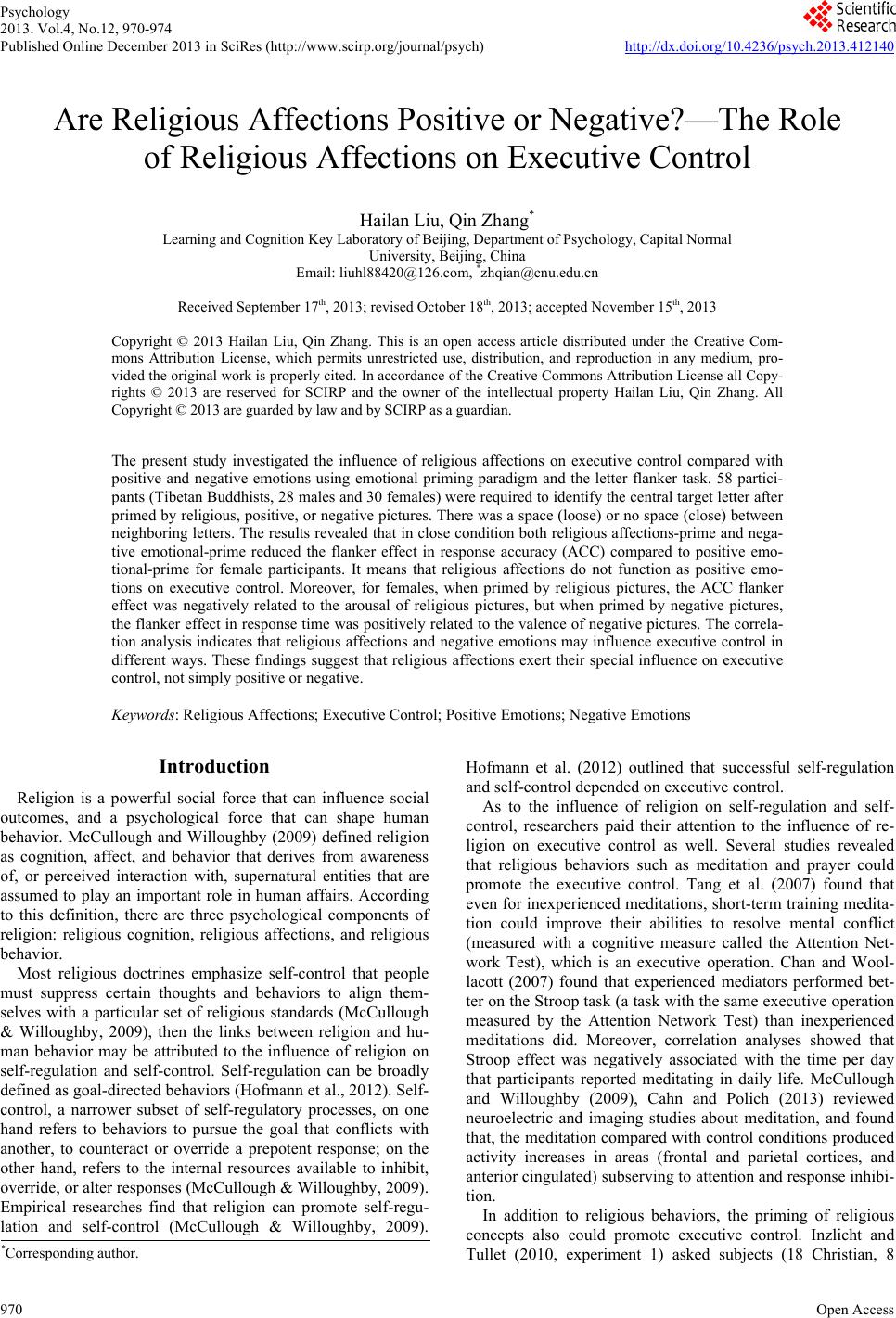 Psychology 2013. Vol.4, No.12, 970-974 Published Online December 2013 in SciRes (http://www.scirp.org/journal/psych) http://dx.doi.org/10.4236/psych.2013.412140 Open Access 970 Are Religious Affections Positive or Negative?—The Role of Religious Affections on Executive Control Hailan Liu, Qin Zhang* Learning and Cognition Key Laboratory of Beijing, Department of Psychology, Capital Normal University, Beijing, China Email: liuhl88420@126.com, *zhqian@cnu.edu.cn Received September 17th, 2013; revised October 18th, 2013; accepted November 15th, 2013 Copyright © 2013 Hailan Liu, Qin Zhang. This is an open access article distributed under the Creative Com- mons Attribution License, which permits unrestricted use, distribution, and reproduction in any medium, pro- vided the original work is properly cited. In accordance of the Creative Commons Attribution License all Copy- rights © 2013 are reserved for SCIRP and the owner of the intellectual property Hailan Liu, Qin Zhang. All Copyright © 2013 are guarded by law and by SCIRP as a guardian. The present study investigated the influence of religious affections on executive control compared with positive and negative emotions using emotional priming paradigm and the letter flanker task. 58 partici- pants (Tibetan Buddhists, 28 males and 30 females) were required to identify the central target letter after primed by religious, positive, or negative pictures. There was a space (loose) or no space (close) between neighboring letters. The results revealed that in close condition both religious affections-prime and nega- tive emotional-prime reduced the flanker effect in response accuracy (ACC) compared to positive emo- tional-prime for female participants. It means that religious affections do not function as positive emo- tions on executive control. Moreover, for females, when primed by religious pictures, the ACC flanker effect was negatively related to the arousal of religious pictures, but when primed by negative pictures, the flanker effect in response time was positively related to the valence of negative pictures. The correla- tion analysis indicates that religious affections and negative emotions may influence executive control in different ways. These findings suggest that religious affections exert their special influence on executive control, not simply positive or negative. Keywords: Religious Affections; Executive Control; Positive Emotions; Negative Emotions Introduction Religion is a powerful social force that can influence social outcomes, and a psychological force that can shape human behavior. McCullough and Willoughby (2009) defined religion as cognition, affect, and behavior that derives from awareness of, or perceived interaction with, supernatural entities that are assumed to play an important role in human affairs. According to this definition, there are three psychological components of religion: religious cognition, religious affections, and religious behavior. Most religious doctrines emphasize self-control that people must suppress certain thoughts and behaviors to align them- selves with a particular set of religious standards (McCullough & Willoughby, 2009), then the links between religion and hu- man behavior may be attributed to the influence of religion on self-regulation and self-control. Self-regulation can be broadly defined as goal-directed behaviors (Hofmann et al., 2012). Self- control, a narrower subset of self-regulatory processes, on one hand refers to behaviors to pursue the goal that conflicts with another, to counteract or override a prepotent response; on the other hand, refers to the internal resources available to inhibit, override, or alter responses (McCullough & Willoughby, 2009). Empirical researches find that religion can promote self-regu- lation and self-control (McCullough & Willoughby, 2009). Hofmann et al. (2012) outlined that successful self-regulation and self-control depended on executive control. As to the influence of religion on self-regulation and self- control, researchers paid their attention to the influence of re- ligion on executive control as well. Several studies revealed that religious behaviors such as meditation and prayer could promote the executive control. Tang et al. (2007) found that even for inexperienced meditations, short-term training medita- tion could improve their abilities to resolve mental conflict (measured with a cognitive measure called the Attention Net- work Test), which is an executive operation. Chan and Wool- lacott (2007) found that experienced mediators performed bet- ter on the Stroop task (a task with the same executive operation measured by the Attention Network Test) than inexperienced meditations did. Moreover, correlation analyses showed that Stroop effect was negatively associated with the time per day that participants reported meditating in daily life. McCullough and Willoughby (2009), Cahn and Polich (2013) reviewed neuroelectric and imaging studies about meditation, and found that, the meditation compared with control conditions produced activity increases in areas (frontal and parietal cortices, and anterior cingulated) subserving to attention and response inhibi- tion. In addition to religious behaviors, the priming of religious concepts also could promote executive control. Inzlicht and Tullet (2010, experiment 1) asked subjects (18 Christian, 8 *Corresponding author. 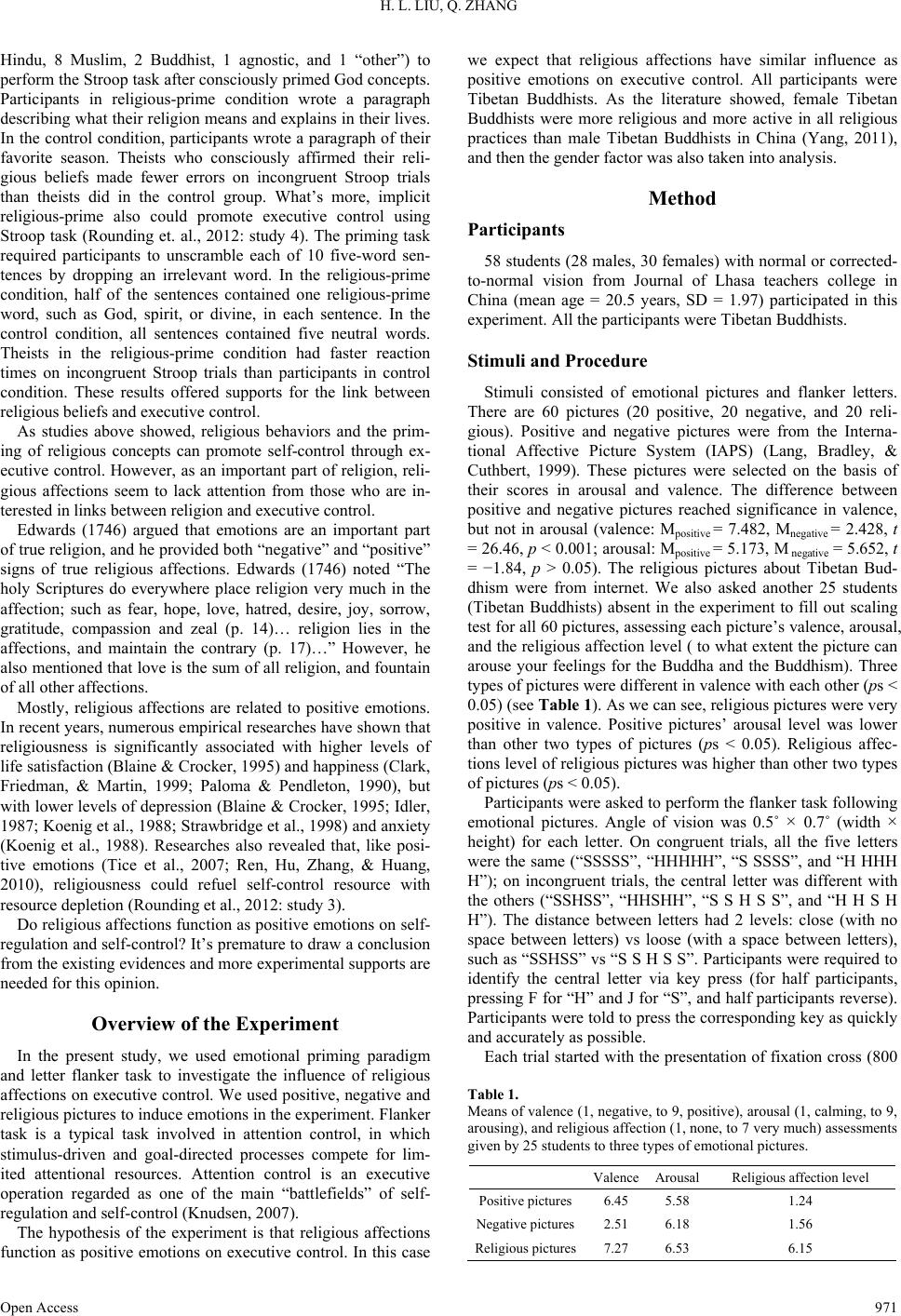 H. L. LIU, Q. ZHANG Hindu, 8 Muslim, 2 Buddhist, 1 agnostic, and 1 “other”) to perform the Stroop task after consciously primed God concepts. Participants in religious-prime condition wrote a paragraph describing what their religion means and explains in their lives. In the control condition, participants wrote a paragraph of their favorite season. Theists who consciously affirmed their reli- gious beliefs made fewer errors on incongruent Stroop trials than theists did in the control group. What’s more, implicit religious-prime also could promote executive control using Stroop task (Rounding et. al., 2012: study 4). The priming task required participants to unscramble each of 10 five-word sen- tences by dropping an irrelevant word. In the religious-prime condition, half of the sentences contained one religious-prime word, such as God, spirit, or divine, in each sentence. In the control condition, all sentences contained five neutral words. Theists in the religious-prime condition had faster reaction times on incongruent Stroop trials than participants in control condition. These results offered supports for the link between religious beliefs and executive control. As studies above showed, religious behaviors and the prim- ing of religious concepts can promote self-control through ex- ecutive control. However, as an important part of religion, reli- gious affections seem to lack attention from those who are in- terested in links between religion and executive control. Edwards (1746) argued that emotions are an important part of true religion, and he provided both “negative” and “positive” signs of true religious affections. Edwards (1746) noted “The holy Scriptures do everywhere place religion very much in the affection; such as fear, hope, love, hatred, desire, joy, sorrow, gratitude, compassion and zeal (p. 14)… religion lies in the affections, and maintain the contrary (p. 17)…” However, he also mentioned that love is the sum of all religion, and fountain of all other affections. Mostly, religious affections are related to positive emotions. In recent years, numerous empirical researches have shown that religiousness is significantly associated with higher levels of life satisfaction (Blaine & Crocker, 1995) and happiness (Clark, Friedman, & Martin, 1999; Paloma & Pendleton, 1990), but with lower levels of depression (Blaine & Crocker, 1995; Idler, 1987; Koenig et al., 1988; Strawbridge et al., 1998) and anxiety (Koenig et al., 1988). Researches also revealed that, like posi- tive emotions (Tice et al., 2007; Ren, Hu, Zhang, & Huang, 2010), religiousness could refuel self-control resource with resource depletion (Rounding et al., 2012: study 3). Do religious affections function as positive emotions on self- regulation and self-control? It’s premature to draw a conclusion from the existing evidences and more experimental supports are needed for this opinion. Overview of the Experiment In the present study, we used emotional priming paradigm and letter flanker task to investigate the influence of religious affections on executive control. We used positive, negative and religious pictures to induce emotions in the experiment. Flanker task is a typical task involved in attention control, in which stimulus-driven and goal-directed processes compete for lim- ited attentional resources. Attention control is an executive operation regarded as one of the main “battlefields” of self- regulation and self-control (Knudsen, 2007). The hypothesis of the experiment is that religious affections function as positive emotions on executive control. In this case we expect that religious affections have similar influence as positive emotions on executive control. All participants were Tibetan Buddhists. As the literature showed, female Tibetan Buddhists were more religious and more active in all religious practices than male Tibetan Buddhists in China (Yang, 2011), and then the gender factor was also taken into analysis. Method Participants 58 students (28 males, 30 females) with normal or corrected- to-normal vision from Journal of Lhasa teachers college in China (mean age = 20.5 years, SD = 1.97) participated in this experiment. All the participants were Tibetan Buddhists. Stimuli and Procedure Stimuli consisted of emotional pictures and flanker letters. There are 60 pictures (20 positive, 20 negative, and 20 reli- gious). Positive and negative pictures were from the Interna- tional Affective Picture System (IAPS) (Lang, Bradley, & Cuthbert, 1999). These pictures were selected on the basis of their scores in arousal and valence. The difference between positive and negative pictures reached significance in valence, but not in arousal (valence: Mpositive = 7.482, Mnegative = 2.428, t = 26.46, p < 0.001; arousal: Mpositive = 5.173, M negative = 5.652, t = −1.84, p > 0.05). The religious pictures about Tibetan Bud- dhism were from internet. We also asked another 25 students (Tibetan Buddhists) absent in the experiment to fill out scaling test for all 60 pictures, assessing each picture’s valence, arousal, and the religious affection level ( to what extent the picture can arouse your feelings for the Buddha and the Buddhism). Three types of pictures were different in valence with each other (ps < 0.05) (see Table 1). As we can see, religious pictures were very positive in valence. Positive pictures’ arousal level was lower than other two types of pictures (ps < 0.05). Religious affec- tions level of religious pictures was higher than other two types of pictures (ps < 0.05). Participants were asked to perform the flanker task following emotional pictures. Angle of vision was 0.5˚ × 0.7˚ (width × height) for each letter. On congruent trials, all the five letters were the same (“SSSSS”, “HHHHH”, “S SSSS”, and “H HHH H”); on incongruent trials, the central letter was different with the others (“SSHSS”, “HHSHH”, “S S H S S”, and “H H S H H”). The distance between letters had 2 levels: close (with no space between letters) vs loose (with a space between letters), such as “SSHSS” vs “S S H S S”. Participants were required to identify the central letter via key press (for half participants, pressing F for “H” and J for “S”, and half participants reverse). Participants were told to press the corresponding key as quickly and accurately as possible. Each trial started with the presentation of fixation cross (800 Table 1. Means of valence (1, negative, to 9, positive), arousal (1, calming, to 9, arousing), and religious affection (1, none, to 7 very much) assessments given by 25 students to three types of emotional pictures. ValenceArousal Religious affection level Positive pictures6.45 5.58 1.24 Negative pictures2.51 6.18 1.56 Religious pictures7.27 6.53 6.15 Open Access 971 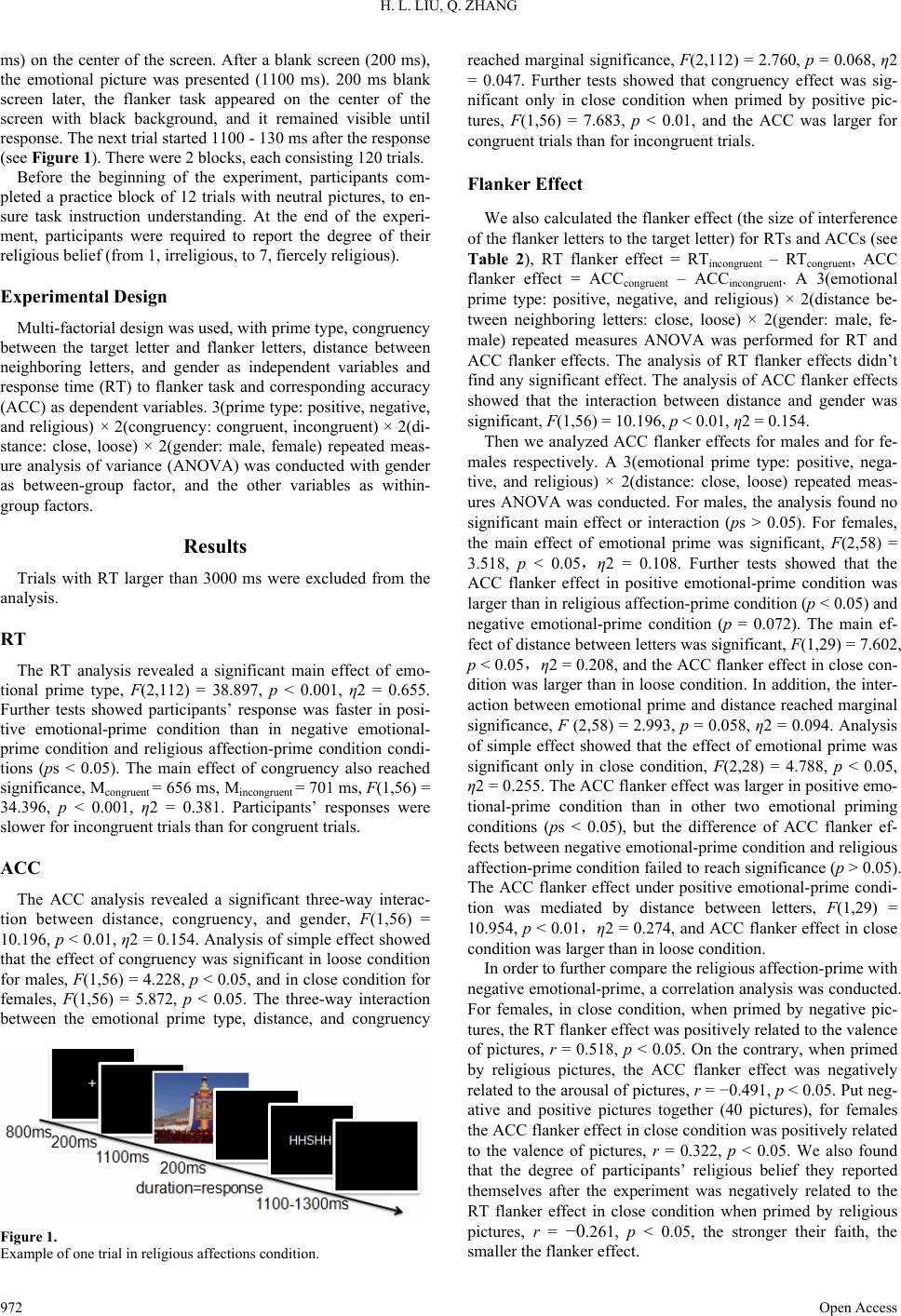 H. L. LIU, Q. ZHANG ms) on the center of the screen. After a blank screen (200 ms), the emotional picture was presented (1100 ms). 200 ms blank screen later, the flanker task appeared on the center of the screen with black background, and it remained visible until response. The next trial started 1100 - 130 ms after the response (see Figure 1). There were 2 blocks, each consisting 120 trials. Before the beginning of the experiment, participants com- pleted a practice block of 12 trials with neutral pictures, to en- sure task instruction understanding. At the end of the experi- ment, participants were required to report the degree of their religious belief (from 1, irreligious, to 7, fiercely religious). Experimental Design Multi-factorial design was used, with prime type, congruency between the target letter and flanker letters, distance between neighboring letters, and gender as independent variables and response time (RT) to flanker task and corresponding accuracy (ACC) as dependent variables. 3(prime type: positive, negative, and religious) × 2(congruency: congruent, incongruent) × 2(di- stance: close, loose) × 2(gender: male, female) repeated meas- ure analysis of variance (ANOVA) was conducted with gender as between-group factor, and the other variables as within- group factors. Results Trials with RT larger than 3000 ms were excluded from the analysis. RT The RT analysis revealed a significant main effect of emo- tional prime type, F(2,112) = 38.897, p < 0.001, η2 = 0.655. Further tests showed participants’ response was faster in posi- tive emotional-prime condition than in negative emotional- prime condition and religious affection-prime condition condi- tions (ps < 0.05). The main effect of congruency also reached significance, Mcongruent = 656 ms, Mincongruent = 701 ms, F(1,56) = 34.396, p < 0.001, η2 = 0.381. Participants’ responses were slower for incongruent trials than for congruent trials. ACC The ACC analysis revealed a significant three-way interac- tion between distance, congruency, and gender, F(1,56) = 10.196, p < 0.01, η2 = 0.154. Analysis of simple effect showed that the effect of congruency was significant in loose condition for males, F(1,56) = 4.228, p < 0.05, and in close condition for females, F(1,56) = 5.872, p < 0.05. The three-way interaction between the emotional prime type, distance, and congruency Figure 1. Example of one trial in religious affections condition. reached marginal significance, F(2,112) = 2.760, p = 0.068, η2 = 0.047. Further tests showed that congruency effect was sig- nificant only in close condition when primed by positive pic- tures, F(1,56) = 7.683, p < 0.01, and the ACC was larger for congruent trials than for incongruent trials. Flanker Effect We also calculated the flanker effect (the size of interference of the flanker letters to the target letter) for RTs and ACCs (see Table 2), RT flanker effect = RTincongruent – RTcongruent, ACC flanker effect = ACCcongruent – ACCincongruent. A 3(emotional prime type: positive, negative, and religious) × 2(distance be- tween neighboring letters: close, loose) × 2(gender: male, fe- male) repeated measures ANOVA was performed for RT and ACC flanker effects. The analysis of RT flanker effects didn’t find any significant effect. The analysis of ACC flanker effects showed that the interaction between distance and gender was significant, F(1,56) = 10.196, p < 0.01, η2 = 0.154. Then we analyzed ACC flanker effects for males and for fe- males respectively. A 3(emotional prime type: positive, nega- tive, and religious) × 2(distance: close, loose) repeated meas- ures ANOVA was conducted. For males, the analysis found no significant main effect or interaction (ps > 0.05). For females, the main effect of emotional prime was significant, F(2,58) = 3.518, p < 0.05,η2 = 0.108. Further tests showed that the ACC flanker effect in positive emotional-prime condition was larger than in religious affection-prime condition (p < 0.05) and negative emotional-prime condition (p = 0.072). The main ef- fect of distance between letters was significant, F(1,29) = 7.602, p < 0.05,η2 = 0.208, and the ACC flanker effect in close con- dition was larger than in loose condition. In addition, the inter- action between emotional prime and distance reached marginal significance, F (2,58) = 2.993, p = 0.058, η2 = 0.094. Analysis of simple effect showed that the effect of emotional prime was significant only in close condition, F(2,28) = 4.788, p < 0.05, η2 = 0.255. The ACC flanker effect was larger in positive emo- tional-prime condition than in other two emotional priming conditions (ps < 0.05), but the difference of ACC flanker ef- fects between negative emotional-prime condition and religious affection-prime condition failed to reach significance (p > 0.05). The ACC flanker effect under positive emotional-prime condi- tion was mediated by distance between letters, F(1,29) = 10.954, p < 0.01,η2 = 0.274, and ACC flanker effect in close condition was larger than in loose condition. In order to further compare the religious affection-prime with negative emotional-prime, a correlation analysis was conducted. For females, in close condition, when primed by negative pic- tures, the RT flanker effect was positively related to the valence of pictures, r = 0.518, p < 0.05. On the contrary, when primed by religious pictures, the ACC flanker effect was negatively related to the arousal of pictures, r = −0.491, p < 0.05. Put neg- ative and positive pictures together (40 pictures), for females the ACC flanker effect in close condition was positively related to the valence of pictures, r = 0.322, p < 0.05. We also found that the degree of participants’ religious belief they reported themselves after the experiment was negatively related to the RT flanker effect in close condition when primed by religious pictures, r = −0.261, p < 0.05, the stronger their faith, the smaller the flanker effect. Open Access 972 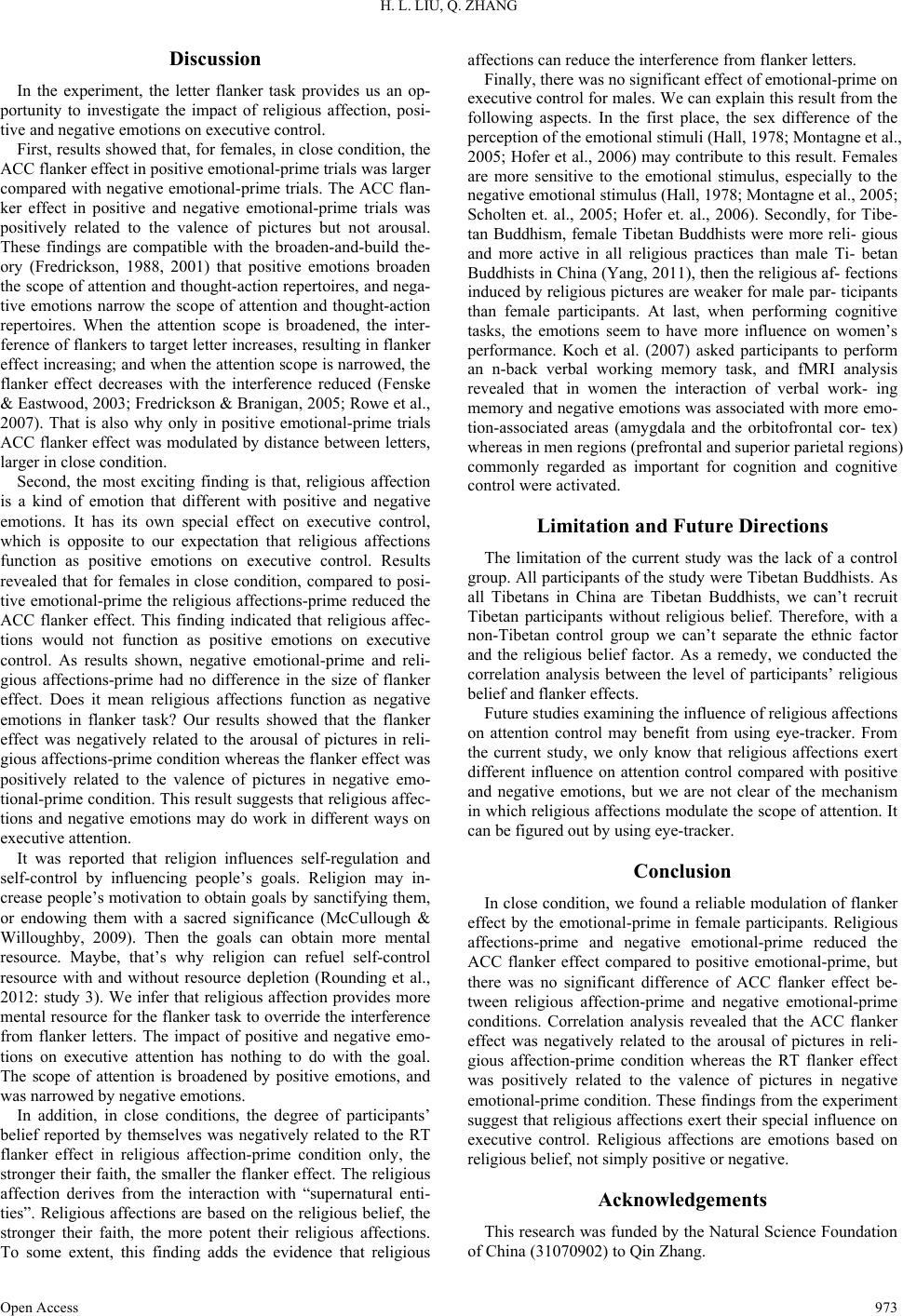 H. L. LIU, Q. ZHANG Discussion In the experiment, the letter flanker task provides us an op- portunity to investigate the impact of religious affection, posi- tive and negative emotions on executive control. First, results showed that, for females, in close condition, the ACC flanker effect in positive emotional-prime trials was larger compared with negative emotional-prime trials. The ACC flan- ker effect in positive and negative emotional-prime trials was positively related to the valence of pictures but not arousal. These findings are compatible with the broaden-and-build the- ory (Fredrickson, 1988, 2001) that positive emotions broaden the scope of attention and thought-action repertoires, and nega- tive emotions narrow the scope of attention and thought-action repertoires. When the attention scope is broadened, the inter- ference of flankers to target letter increases, resulting in flanker effect increasing; and when the attention scope is narrowed, the flanker effect decreases with the interference reduced (Fenske & Eastwood, 2003; Fredrickson & Branigan, 2005; Rowe et al., 2007). That is also why only in positive emotional-prime trials ACC flanker effect was modulated by distance between letters, larger in close condition. Second, the most exciting finding is that, religious affection is a kind of emotion that different with positive and negative emotions. It has its own special effect on executive control, which is opposite to our expectation that religious affections function as positive emotions on executive control. Results revealed that for females in close condition, compared to posi- tive emotional-prime the religious affections-prime reduced the ACC flanker effect. This finding indicated that religious affec- tions would not function as positive emotions on executive control. As results shown, negative emotional-prime and reli- gious affections-prime had no difference in the size of flanker effect. Does it mean religious affections function as negative emotions in flanker task? Our results showed that the flanker effect was negatively related to the arousal of pictures in reli- gious affections-prime condition whereas the flanker effect was positively related to the valence of pictures in negative emo- tional-prime condition. This result suggests that religious affec- tions and negative emotions may do work in different ways on executive attention. It was reported that religion influences self-regulation and self-control by influencing people’s goals. Religion may in- crease people’s motivation to obtain goals by sanctifying them, or endowing them with a sacred significance (McCullough & Willoughby, 2009). Then the goals can obtain more mental resource. Maybe, that’s why religion can refuel self-control resource with and without resource depletion (Rounding et al., 2012: study 3). We infer that religious affection provides more mental resource for the flanker task to override the interference from flanker letters. The impact of positive and negative emo- tions on executive attention has nothing to do with the goal. The scope of attention is broadened by positive emotions, and was narrowed by negative emotions. In addition, in close conditions, the degree of participants’ belief reported by themselves was negatively related to the RT flanker effect in religious affection-prime condition only, the stronger their faith, the smaller the flanker effect. The religious affection derives from the interaction with “supernatural enti- ties”. Religious affections are based on the religious belief, the stronger their faith, the more potent their religious affections. To some extent, this finding adds the evidence that religious affections can reduce the interference from flanker letters. Finally, there was no significant effect of emotional-prime on executive control for males. We can explain this result from the following aspects. In the first place, the sex difference of the perception of the emotional stimuli (Hall, 1978; Montagne et al., 2005; Hofer et al., 2006) may contribute to this result. Females are more sensitive to the emotional stimulus, especially to the negative emotional stimulus (Hall, 1978; Montagne et al., 2005; Scholten et. al., 2005; Hofer et. al., 2006). Secondly, for Tibe- tan Buddhism, female Tibetan Buddhists were more reli- gious and more active in all religious practices than male Ti- betan Buddhists in China (Yang, 2011), then the religious af- fections induced by religious pictures are weaker for male par- ticipants than female participants. At last, when performing cognitive tasks, the emotions seem to have more influence on women’s performance. Koch et al. (2007) asked participants to perform an n-back verbal working memory task, and fMRI analysis revealed that in women the interaction of verbal work- ing memory and negative emotions was associated with more emo- tion-associated areas (amygdala and the orbitofrontal cor- tex) whereas in men regions (prefrontal and superior parietal regions) commonly regarded as important for cognition and cognitive control were activated. Limitation and Future Directions The limitation of the current study was the lack of a control group. All participants of the study were Tibetan Buddhists. As all Tibetans in China are Tibetan Buddhists, we can’t recruit Tibetan participants without religious belief. Therefore, with a non-Tibetan control group we can’t separate the ethnic factor and the religious belief factor. As a remedy, we conducted the correlation analysis between the level of participants’ religious belief and flanker effects. Future studies examining the influence of religious affections on attention control may benefit from using eye-tracker. From the current study, we only know that religious affections exert different influence on attention control compared with positive and negative emotions, but we are not clear of the mechanism in which religious affections modulate the scope of attention. It can be figured out by using eye-tracker. Conclusion In close condition, we found a reliable modulation of flanker effect by the emotional-prime in female participants. Religious affections-prime and negative emotional-prime reduced the ACC flanker effect compared to positive emotional-prime, but there was no significant difference of ACC flanker effect be- tween religious affection-prime and negative emotional-prime conditions. Correlation analysis revealed that the ACC flanker effect was negatively related to the arousal of pictures in reli- gious affection-prime condition whereas the RT flanker effect was positively related to the valence of pictures in negative emotional-prime condition. These findings from the experiment suggest that religious affections exert their special influence on executive control. Religious affections are emotions based on religious belief, not simply positive or negative. Acknowledgements This research was funded by the Natural Science Foundation of China (31070902) to Qin Zhang. Open Access 973 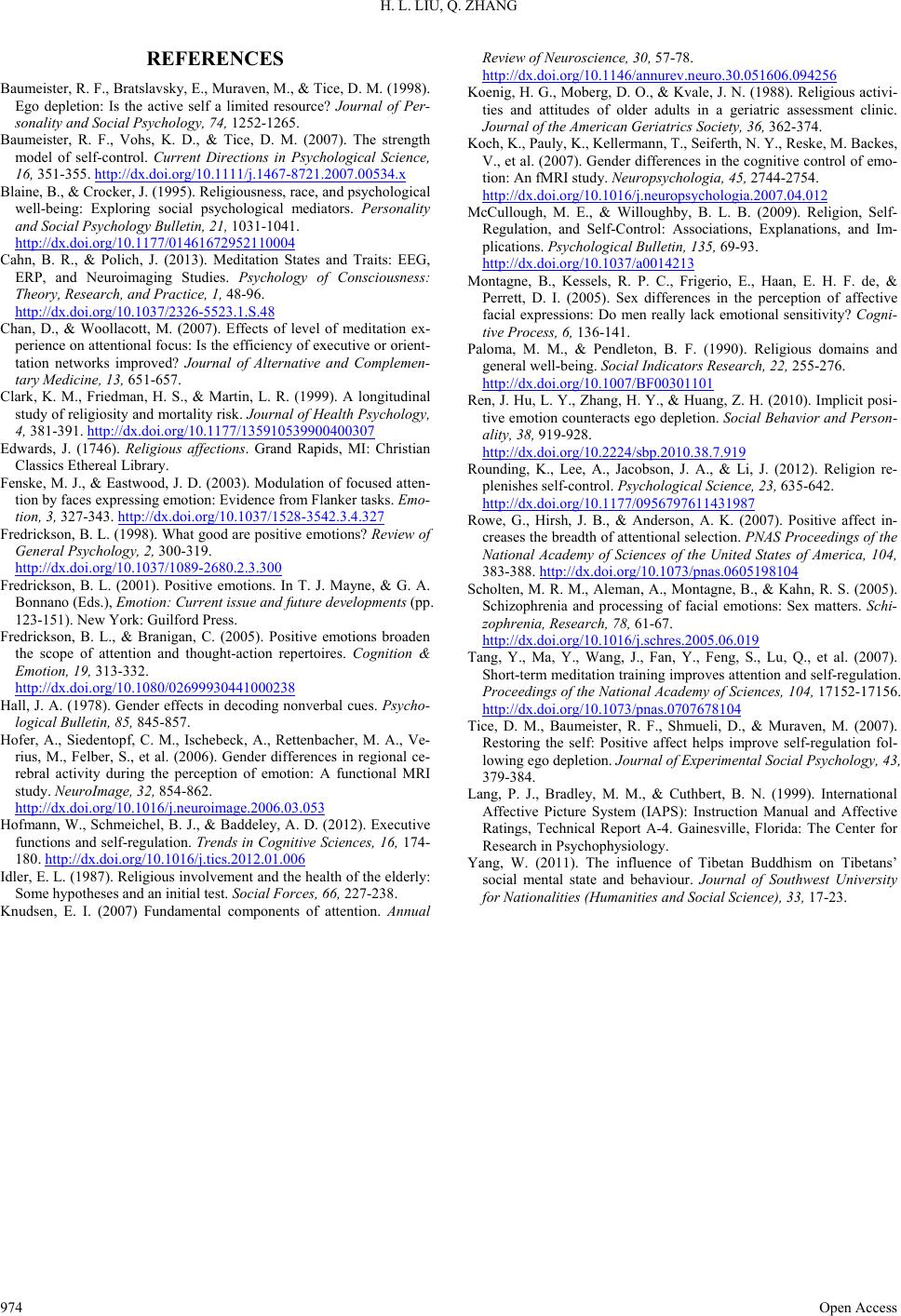 H. L. LIU, Q. ZHANG Open Access 974 REFERENCES Baumeister, R. F., Bratslavsky, E., Muraven, M., & Tice, D. M. (1998). Ego depletion: Is the active self a limited resource? Journal of Per- sonality and Social Psychology, 74, 1252-1265. Baumeister, R. F., Vohs, K. D., & Tice, D. M. (2007). The strength model of self-control. Current Directions in Psychological Science, 16, 351-355. http://dx.doi.org/10.1111/j.1467-8721.2007.00534.x Blaine, B., & Crocker, J. (1995). Religiousness, race, and psychological well-being: Exploring social psychological mediators. Personality and Social Psychology Bulletin, 21, 1031-1041. http://dx.doi.org/10.1177/01461672952110004 Cahn, B. R., & Polich, J. (2013). Meditation States and Traits: EEG, ERP, and Neuroimaging Studies. Psychology of Consciousness: Theory, Research, and Practice, 1, 48-96. http://dx.doi.org/10.1037/2326-5523.1.S.48 Chan, D., & Woollacott, M. (2007). Effects of level of meditation ex- perience on attentional focus: Is the efficiency of executive or orient- tation networks improved? Journal of Alternative and Complemen- tary Medicine, 13, 651-657. Clark, K. M., Friedman, H. S., & Martin, L. R. (1999). A longitudinal study of religiosity and mortality risk. Journal of Health Psychology, 4, 381-391. http://dx.doi.org/10.1177/135910539900400307 Edwards, J. (1746). Religious affections. Grand Rapids, MI: Christian Classics Ethereal Library. Fenske, M. J., & Eastwood, J. D. (2003). Modulation of focused atten- tion by faces expressing emotion: Evidence from Flanker tasks. Emo- tion, 3, 327-343. http://dx.doi.org/10.1037/1528-3542.3.4.327 Fredrickson, B. L. (1998). What good are positive emotions? Review of General Psychology, 2, 300-319. http://dx.doi.org/10.1037/1089-2680.2.3.300 Fredrickson, B. L. (2001). Positive emotions. In T. J. Mayne, & G. A. Bonnano (Eds.), Emotion: Current issue and future developments (pp. 123-151). New York: Guilford Press. Fredrickson, B. L., & Branigan, C. (2005). Positive emotions broaden the scope of attention and thought-action repertoires. Cognition & Emotion, 19, 313-332. http://dx.doi.org/10.1080/02699930441000238 Hall, J. A. (1978). Gender effects in decoding nonverbal cues. Psycho- logical Bulletin, 85, 845-857. Hofer, A., Siedentopf, C. M., Ischebeck, A., Rettenbacher, M. A., Ve- rius, M., Felber, S., et al. (2006). Gender differences in regional ce- rebral activity during the perception of emotion: A functional MRI study. NeuroImage, 32, 854-862. http://dx.doi.org/10.1016/j.neuroimage.2006.03.053 Hofmann, W., Schmeichel, B. J., & Baddeley, A. D. (2012). Executive functions and self-regulation. Trends in Cognitive Sciences, 16, 174- 180. http://dx.doi.org/10.1016/j.tics.2012.01.006 Idler, E. L. (1987). Religious involvement and the health of the elderly: Some hypotheses and an initial test. Social Forces, 66, 227-238. Knudsen, E. I. (2007) Fundamental components of attention. Annual Review of Neuroscience, 30, 57-78. http://dx.doi.org/10.1146/annurev.neuro.30.051606.094256 Koenig, H. G., Moberg, D. O., & Kvale, J. N. (1988). Religious activi- ties and attitudes of older adults in a geriatric assessment clinic. Journal of the American Geriatrics Society, 36, 362-374. Koch, K., Pauly, K., Kellermann, T., Seiferth, N. Y., Reske, M. Backes, V., et al. (2007). Gender differences in the cognitive control of emo- tion: An fMRI study. Neuropsychologia, 45, 2744-2754. http://dx.doi.org/10.1016/j.neuropsychologia.2007.04.012 McCullough, M. E., & Willoughby, B. L. B. (2009). Religion, Self- Regulation, and Self-Control: Associations, Explanations, and Im- plications. Psychological Bulletin, 135, 69-93. http://dx.doi.org/10.1037/a0014213 Montagne, B., Kessels, R. P. C., Frigerio, E., Haan, E. H. F. de, & Perrett, D. I. (2005). Sex differences in the perception of affective facial expressions: Do men really lack emotional sensitivity? Cogni- tive Process, 6, 136-141. Paloma, M. M., & Pendleton, B. F. (1990). Religious domains and general well-being. Social Indicators Research, 22, 255-276. http://dx.doi.org/10.1007/BF00301101 Ren, J. Hu, L. Y., Zhang, H. Y., & Huang, Z. H. (2010). Implicit posi- tive emotion counteracts ego depletion. Social Behavior and Person- ality, 38, 919-928. http://dx.doi.org/10.2224/sbp.2010.38.7.919 Rounding, K., Lee, A., Jacobson, J. A., & Li, J. (2012). Religion re- plenishes self-control. Psychological Science, 23, 635-642. http://dx.doi.org/10.1177/0956797611431987 Rowe, G., Hirsh, J. B., & Anderson, A. K. (2007). Positive affect in- creases the breadth of attentional selection. PNAS Proceedings of the National Academy of Sciences of the United States of America, 104, 383-388. http://dx.doi.org/10.1073/pnas.0605198104 Scholten, M. R. M., Aleman, A., Montagne, B., & Kahn, R. S. (2005). Schizophrenia and processing of facial emotions: Sex matters. Schi- zophrenia, Research, 78, 61-67. http://dx.doi.org/10.1016/j.schres.2005.06.019 Tang, Y., Ma, Y., Wang, J., Fan, Y., Feng, S., Lu, Q., et al. (2007). Short-term meditation training improves attention and self-regulation. Proceedings of the National Academy of Sciences, 104, 17152-17156. http://dx.doi.org/10.1073/pnas.0707678104 Tice, D. M., Baumeister, R. F., Shmueli, D., & Muraven, M. (2007). Restoring the self: Positive affect helps improve self-regulation fol- lowing ego depletion. Journal of Experimental Social Psychology, 43, 379-384. Lang, P. J., Bradley, M. M., & Cuthbert, B. N. (1999). International Affective Picture System (IAPS): Instruction Manual and Affective Ratings, Technical Report A-4. Gainesville, Florida: The Center for Research in Psychophysiology. Yang, W. (2011). The influence of Tibetan Buddhism on Tibetans’ social mental state and behaviour. Journal of Southwest University for Nationalities (Humanities and Social Science), 33, 17-23.
|